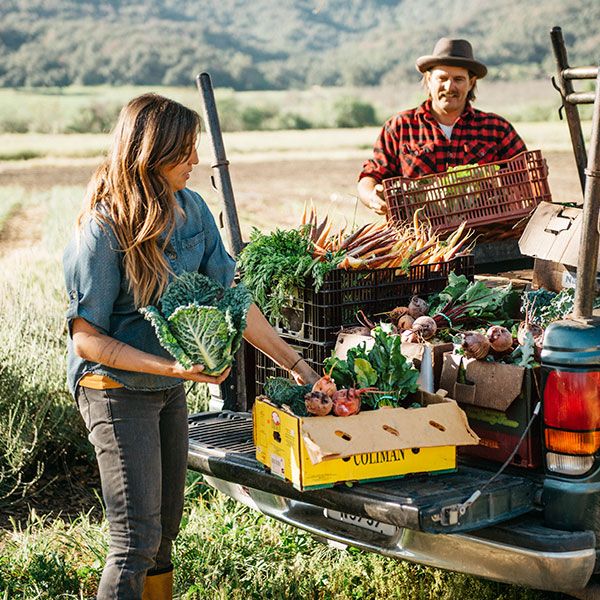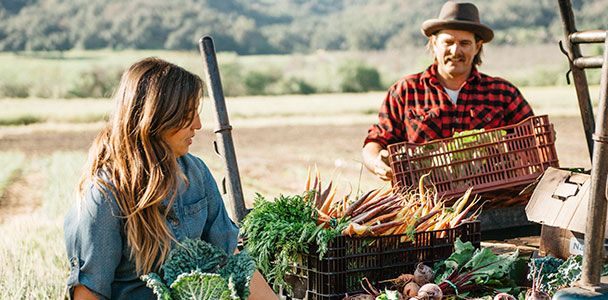
In a dusty, sun-baked field,John Fonteyn moves down a row of volleyball-size cabbages, swiftly freeing them from their stalks with his knife and an easy grace. There is birdsong and wind song and China-blue sky in this pastoral spot in California’s Ojai Valley. He talks as he bends to his task. “Farming is the single greatest contribution mankind has made to the planet,” he says to his visitor. “We’re participating in a 12,000-year-old ritual, again and again.” Then he straightens, a heavy green orb dangling from one hand, his cutter’s worn handle in the other, and throws his arms wide. “It’s hard to quantify how rich this makes your life.”
See more photos of the Rio Gozo Farm: An American Homegrown Passion: Growing a Small Family Farm
Two rows away, Elizabeth Del Negro, John’s wife, is harvesting celery, her fingers black with soil. She doesn’t stop to philosophize. Today, Tuesday, is their farm’s busiest time of the week. A lot of vegetables need to be picked, packed in boxes, and delivered. “People like to talk about the glories of farming,” she says. “But a lot of it is crawling around on your hands and knees, scraping the earth with bloody knuckles. You’ve got to be a nuts-and-bolts kind of person.”
The couple live just down the hill. They farm on three plots totaling roughly eight acres—five of them leased, for they are first-generation farmers—in this rural pocket 65 miles north of Los Angeles. Elizabeth, 39, was raised here.
Her father was a chef; they had chickens, fruit trees, and a vegetable garden. John, 40, a child of academics, grew up mostly near Austin, Texas, though his family lived for a time in both San Francisco and nearby Santa Barbara. His ecologist father liked to regale him with plant intricacies. “Back then, I couldn’t have cared less,” he admits.
Elizabeth left Ojai to wander during her twenties, climbing and working as a cook with Outward Bound. John ambled too, traveling in Central and South America, nurturing his love of cooking. Eventually, both drifted back. John married, had a son, divorced. The two met through friends. Along with chemistry, food bonded them. On their first date, they foraged for chanterelles. Their wedding favors were packets of kale seeds.
See how to start your own vegetable garden: Grow a Healthy Vegetable Garden
The couple started Rio Gozo Farm (“river of joy” in Spanish) six years ago, marrying a year later. From the outset, the farm embraced the CSA model. Community-supported agriculture, which began in the U.S. in the 1980s, works simply. Members buy shares before the growing season, giving farmers cash to pay for seed and equipment. As crops grow, subscribers receive a weekly share of the harvest. Investments carry risk, of course. If water is scarce, you get wilted lettuce. Farms can fail.
The latest U.S. Department of Agriculture census, from 2012, counted 12,617 American farms participating in CSA programs. LocalHarvest, a liaison between farmers and locavore consumers, lists around 4,000 on its website, most small organic growers. CSAs help farms sell directly to their neighbors, upping profits. Members—who may live in nearby cities, where farm stands are scarce—receive the freshest food and get to know their farmers and like-minded foodies. Most CSAs hold distribution hobnobs in their barns or at central sites; shareholders collect their boxes, swap recipes, talk tomatoes. Some CSAs deliver door-to-door, milkman style.
“The essence of CSA is really the community it creates,” says Elizabeth. And since a farmer’s chores are never done, it’s helpful when that community also does field work. On this day, John and Elizabeth’s part-time staff of one, Lyz Merola, is on the job, and four sweat-equity members are picking too, in exchange for their share of vegetables. One of them, Bobby Schmid, washes beets in a wheelbarrow under a walnut tree. He joined the CSA three years ago. “My kids end up eating vegetables they normally wouldn’t,” he says, looking up from beneath a floppy white hat as he works. “We’ve become so accustomed to the higher quality of the food, the store-bought stuff doesn’t do it for us anymore. And it’s helped us connect to our community and the land.”
As Bobby scrubs, John adds a full crate to the cornucopia in his truck bed. Peering at the assemblage of colors—red and yellow beets, orange Nantes carrots, purple and white kohlrabi, green cabbages—he nods. “Your eyes are your first stomach,” he says. “If something looks good, it tastes good. If you buy from a farmer who picked it that day, it’s going to taste better.”
Culling the produce from the field takes three hours. Then the crew drives it down to Elizabeth and John’s, to fill the week’s 36 CSA-share boxes for delivery. Beneath the open-air packing shed in front of the house, the workers fall to task: clean, trim, sort, carefully repack, so that neither customers nor vegetables will be displeased. Some of the boxes will be dropped at subscriber pickup sites, others at homes. Crates of direct-sale goods will be trucked to area restaurants, markets, school cafeterias, and the local hospital.
According to Elizabeth, John is the visionary, she is the organizer. They agree on what to grow and how much, but she implements the plan, while he handles sales. As she puts it, “He’s the preacher. I build the church.”
On a small farm, everybody lends a hand. John’s 12-year-old son, Trey, shepherds Rio Gozo’s two goats (this he likes) and cleans up after the 20 chickens (this he likes less) residing on the three-acre farmstead. Elizabeth cares for the two piglets, while 18 quail wander free.
See how to design vegetable garden in your yard: The Incredible Edible Landscape
Once packing is complete, John drives off to deliver to town. Elizabeth, boxes stacked inside a weathered van, makes the CSA drops and takes restaurant orders to Ventura and Oxnard, 30 minutes away.
By the time she turns back into the dirt driveway, afternoon has softened into evening. She kills the engine. There is dust, and the ticking of contracting metal as the van cools. Tired, she steps from the van, then heads for the garage to plant seeds. “If you don’t push,” she says, “you don’t keep ahead.”
The more you know Elizabeth and John, the more you see they are the same. They’re not afraid to try. They have a mutual, bring-it-on attitude. “It’s kind of an overconfidence,” she says. “We figured this has worked for farmers who had far more rudimentary tools. We didn’t know when we started whether it would work, and we’ve wanted to quit more than once. But we don’t.” Sink or swim. The decision is innate.
The joy is equally pure. As is always the case with good food, what Rio Gozo Farm grows brings people together. Elizabeth and John offer farm education, hosting groups of local schoolchildren through Food for Thought Ojai; the kids uproot carrots and crunch on them during a talk about sustainable farming. The couple occasionally cater events on-site, but more often they throw potluck gatherings for their wide circle of friends—musicians, vintners, teachers, pilots. Just a week or so before, they hosted a wedding celebration for Elizabeth’s cousin Summer Aronson, who had eloped.
On that afternoon, family and friends gathered in front of the couple’s home for laughter and homemade tacos. As kids scampered through the field and daylight faded, a bonfire came to life, and there was more laughter, and cheesecake. Elizabeth and John do for their friends, and their friends do for them. “How nice it is to be surrounded by brilliant, beautiful, caring people,” John says. “You end up with a rich life that has nothing to do with money.”

